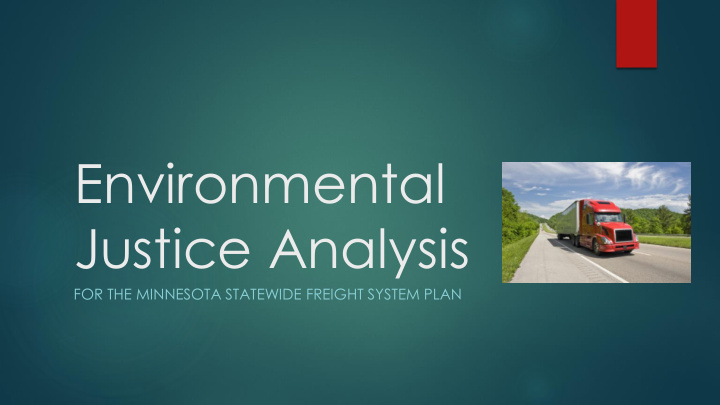



Environmental Justice Analysis FOR THE MINNESOTA STATEWIDE FREIGHT SYSTEM PLAN
Presentation Overview Minnesota Freight Plan Summary Environmental Justice (EJ) Background Freight Plan EJ Analysis Methodology and Results How results will be used Limitations of current approach Opportunities for improvement
Minnesota Freight Plan Minnesota’s Family of Plans
Minnesota Freight Plan Federal Requirements of MAP-21 and FAST Act Importance of Freight to Minnesota Identification of Minnesota Principal Freight Network Freight Action Agenda Plan proposes 30 specific actions Freight Plan Implementation Role of the Minnesota Freight Advisory Committee
Environmental Justice and Title VI Policy Background Civil Rights Act of 1964, Title VI Environmental Justice Executive Order (EO 12898) USDOT Order 5610.2(a) Actions to Address Environmental Justice in Minority Populations and Low-Income Populations Definition of “Low - Income” and “Minority” Definition of “disproportionately high and adverse effect” Overlap between Title VI and EJ Title VI requirements broader, do not include low-income
Existing Guidance and Best Practices DOTs, MPOs, and Transit Agencies have used variety of approaches NCHRP Report 532: Effective Methods for Environmental Justice Assessment Threshold Analysis Method Spatial Interpolation Method Other Guidance FTA Title VI and Environmental Justice Circulars GDOT Report on Impact of EJ Analysis on Transportation Planning FHWA EJ Guidance
EJ Analysis: Statewide Demographic Overview Population Groups Minority Black or African American American Indian and Alaskan Native Asian Native Hawaiian or Other Pacific Islander Hispanic or Latino Low-Income DHHS Poverty Thresholds Additional Groups Senior (65 and Older); Youth (17 and Younger); Limited English Proficiency; Zero- Vehicle Households Threshold Maps
EJ Analysis Methodology and Results
EJ Analysis: Freight Network Buffer Analysis Identification of Principal Freight Network (PFN) Defining adverse impacts Noise, Air Pollution, Vibration ¼-Mile Impact Distance Census Data Preparation Allocating Block Group Data to Blocks Identifying Blocks within Impact Distance Polygon Within Polygon Intersect Centroid Within Areal Interpolation
EJ Analysis: Highway Buffer Results Population Category Statewide Population Population in Buffer Percentage in Buffer Comparison Index Total Population 5,383,661 3,456,101 64% - White 4,585,781 2,946,368 64% 1.00 Black or African 290,545 186,207 64% 1.00 American American Indian and 56,490 36,366 64% 1.00 Alaska Native Asian 230,798 143,691 62% 0.97 Native Hawaiian or 2,166 1,412 65% 1.02 Other Pacific Island Some Other Race 78,863 53,198 67% 1.05 Two or More Races 139,018 88,859 64% 1.00 Hispanic or Latino 264,265 173,885 66% 1.02 Age 65 and Older 730,382 484,302 66% 1.03 Age 17 and Under 1,280,022 812,530 63% 0.99 Low-Income 605,761 408,440 67% 1.05 Limited English 217,737 142,351 65% 1.02 Speaking Individuals Zero-Vehicle 153,366 109,084 71% 1.11 Households
EJ Analysis: Rail Corridor Buffer Results Population Category Statewide Population Population in Buffer Percentage in Buffer Comparison Index Total Population 5,383,661 1,309,874 24% - White 4,585,781 1,127,401 25% 1.01 Black or African 290,545 64,001 22% 0.91 American American Indian and 56,490 13,121 23% 0.95 Alaska Native Asian 230,798 52,104 23% 0.93 Native Hawaiian or 2,166 491 23% 0.93 Other Pacific Island Some Other Race 78,863 19,501 25% 1.02 Two or More Races 139,018 33,255 24% 0.98 Hispanic or Latino 264,265 65,804 25% 1.02 Age 65 and Older 730,382 180,907 25% 1.02 Age 17 and Under 1,280,022 306,731 24% 0.98 Low-Income 605,761 167,726 28% 1.14 Limited English 217,737 50,910 23% 0.96 Speaking Individuals Zero-Vehicle 153,366 40,872 27% 1.10 Households
EJ Analysis: Rail Facility Buffer Results Population Category Statewide Population Population in Buffer Percentage in Buffer Comparison Index Total Population 5,383,661 51,525 0.96% - White 4,585,781 40,161 0.88% 0.92 Black or African 290,545 4,941 1.70% 1.78 American American Indian and 56,490 787 1.39% 1.46 Alaska Native Asian 230,798 2,326 1.01% 1.05 Native Hawaiian or 2,166 20 0.92% 0.96 Other Pacific Island Some Other Race 78,863 1,079 1.37% 1.43 Two or More Races 139,018 2,211 1.59% 1.66 Hispanic or Latino 264,265 3,070 1.16% 1.21 Age 65 and Older 730,382 5,072 0.69% 0.73 Age 17 and Under 1,280,022 10,658 0.83% 0.87 Low-Income 605,761 9,681 1.60% 1.67 Limited English 217,737 2,563 1.18% 1.23 Speaking Individuals Zero-Vehicle 153,366 2,319 1.51% 1.58 Households
What’s the Point? Establishes strong knowledge base of potential EJ issues Provides policy framework for additional review of individual projects and programs If disproportionate adverse impacts are found for projects or programs, steps should be taken to avoid, minimize, or mitigate those impacts Public Participation will be key for project and program reviews
Limitations and Lessons Learned Methodology will be sensitive to inputs Buffer Distance Census Area Selection Reference Population Intensity of Impacts are not incorporated Heavy Commercial ADT or daily train counts could be proxy measures Different Modes will have different impacts
Chris Ryan, PE John Tompkins SRF Consulting Group Minnesota Department of Transportation cryan@srfconsulting.com john.tompkins@state.mn.us For more information on the Minnesota Statewide Freight System Plan: https://www.dot.state.mn.us/planning/freightplan
Recommend
More recommend